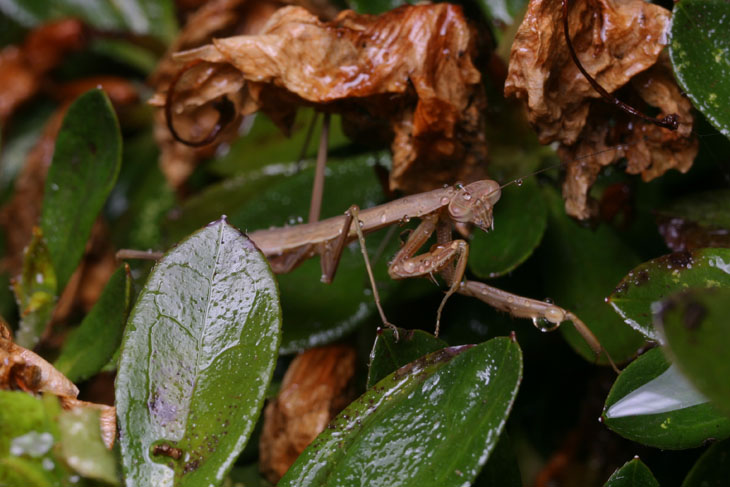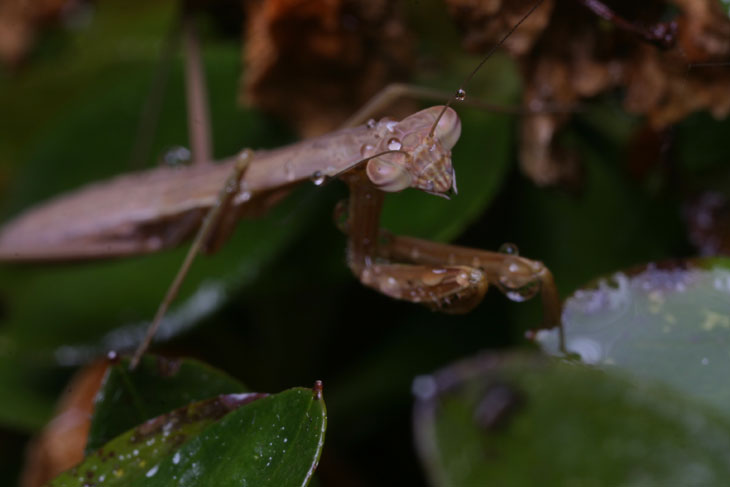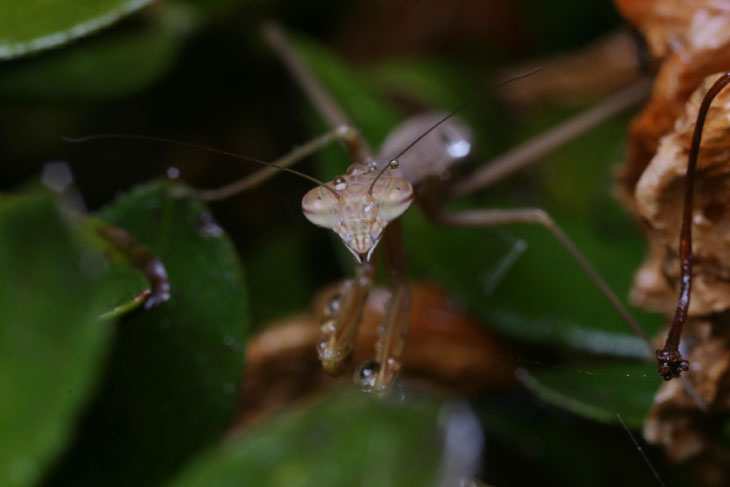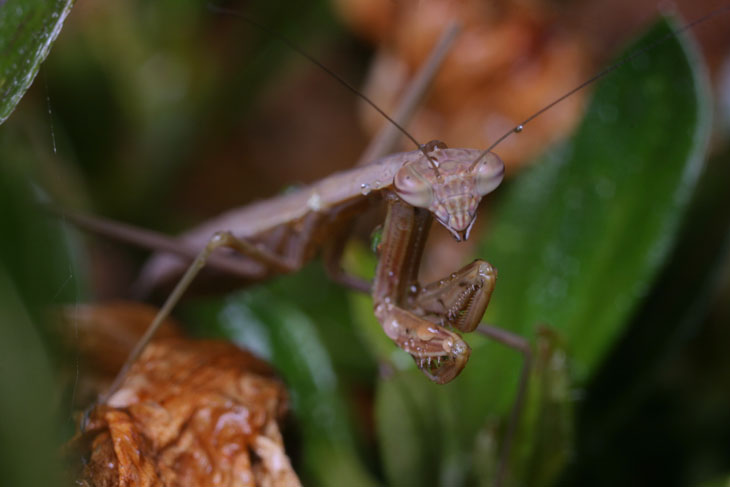
We had gone through a longish period with no rain, and the azalea bushes were started to suffer from it. So I pulled out the hose and gave them a good soaking, with a heavy stream directed at the base to reach the roots, then a light misting over the top to make the insects happy. Almost immediately, the one brown resident mantis scampered excitedly into the water. I really can’t interpret this any other way; it was not trying to escape the soaking, nor did it appear to have been ‘flushed out,’ and had not been visible above the leaves before I started. It simply appeared right in the midst of the mist and came fully out into the open. Of course, I had to get a pic that attempted to communicate this behavior.
Now, it comes as no surprise, I imagine, that blogs are self-edited, which means that not only do you get to see the sentence structure and subject matter that I consider worthwhile (for better or worse,) but also the images that I feel illustrate them best. Until now. I took several images of my friend enjoying the soaking, and decided on the one above. So here are the other choices, all full frame, followed by the reasons why I ruled them out.

Not quite. While it showed the body color and the moisture, and even the sorry state of the formerly-vibrant blooms, the lighting is uneven and the perspective too impersonal. While I might have been misinterpreting the mantis as enjoying the water, this doesn’t show the behavior anyway; more the opposite.

More of a portrait than an illustration of behavior, and the wetness of the entire bush doesn’t come through too well.

Same thing, even more so. The droplet on the antenna is eye-catching, but so is the reflection from the drop on the abdomen, unfocused as it is, and the forelegs almost look like they belong to something else. Plus that stamen to the right is distractingly sharp, though that could have been cropped out easily…

Now, I really like this image, with the focus on the forelegs and the drops, but it’s admittedly a rather menacing impression. And again, it’s a portrait, not a display of the behavior I was describing. Hopefully, you agree that the first was the one to use for the topic. There are times when I’ve gone out to reshoot something specifically to illustrate a post better, and this says nothing of the effort put into the images for book reviews (that one is indeed ‘shopped, since I couldn’t locate a goat when I needed one, so I used an archive goat pic and photographed the book in the position and lighting to match.)
There are a couple of messages here. The first is, take enough images to provide a choice, a selection of conditions, behaviors, angles, and so on. Sometimes, one of them will stand out as expressing an idea much better than the others. Secondly, you’ll have plenty of flexibility when it comes to end usage, which may not be what you originally had in mind when getting the shots. In cases where there’s a different editor than yourself, you have to meet with their expectations.
Also worth considering, especially with macro work and its tight margins, is that focus might not be bang on, or minor movement may have destroyed sharpness – something that the preview image in the LCD on the camera will not tell you. Multiple shots are greater insurance that you have something usable. And when using flash for lighting, varying angles usually give differing results with reflections and shadows, something not at all visible in the viewfinder.
Obviously this is where digital shines, but even when shooting film, multiple images are a good idea – it would be nice to think that every shot is sacred and shouldn’t be wasted, but quite unrealistic. If you get one image that significantly surpasses the others, especially if it makes the sale, then throwing away a few slides isn’t any great loss.
 After dousing the bush, naturally, the rain started later in the evening – yes, the weather report had indicated the possibility, but this is North Carolina, where that’s perhaps even more questionable than other areas of the country. I’ve learned my lesson before by almost killing plants in the garden, waiting for the promised rains that never came, and now water as needed regardless of the threats. The mantises appear quite happy with the rain, sitting well out into the open, and so is another resident. Just yesterday (as I type this draft; probably several days ago now that this post is published,) I was thinking that I hadn’t seen the tiny green lynx spider after that first day, and figured that it had fallen prey to the mantises. Just to prove me wrong, it reappeared on the same bush, still only centimeters away from the (now much bigger) mantids. Somehow it appears to be coping with less aplomb than my model above, though that’s just an impression; both species are probably equally capable of dealing with rain. But it does seem that the mantises are finding more to eat.
After dousing the bush, naturally, the rain started later in the evening – yes, the weather report had indicated the possibility, but this is North Carolina, where that’s perhaps even more questionable than other areas of the country. I’ve learned my lesson before by almost killing plants in the garden, waiting for the promised rains that never came, and now water as needed regardless of the threats. The mantises appear quite happy with the rain, sitting well out into the open, and so is another resident. Just yesterday (as I type this draft; probably several days ago now that this post is published,) I was thinking that I hadn’t seen the tiny green lynx spider after that first day, and figured that it had fallen prey to the mantises. Just to prove me wrong, it reappeared on the same bush, still only centimeters away from the (now much bigger) mantids. Somehow it appears to be coping with less aplomb than my model above, though that’s just an impression; both species are probably equally capable of dealing with rain. But it does seem that the mantises are finding more to eat.




















































